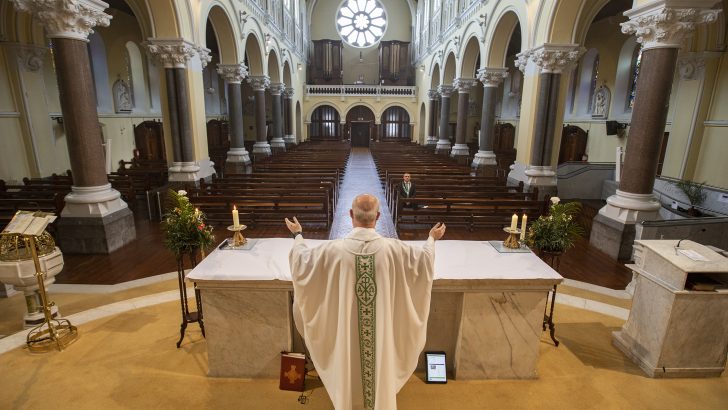When the pandemic is finally over, the livelihoods of very many people will be harmed and the damage will be huge, writes David Quinn
The pandemic is increasing feelings of anxiety among the population, with a bigger effect on women than men. This has now been confirmed by new data from the Central Statistics Office (CSO) which is tracking the effect of this unprecedented situation on the lives of people, including their mental health.
The latest CSO release on the subject is called ‘Social Impact of Covid-19 on Women and Men’. It was conducted in April. Among its findings is that whereas 22% of men reported a drop in feelings of life satisfaction in that month, among women the figure is much higher at 36.7%. If people are surveyed again in May, what will it show?
The report also finds that women are more anxious about themselves and other people than men are, and in addition have increased their consumption of alcohol, tobacco and junk food more than men have.
Clear majority
In keeping with the above, women are more likely than men to keep to the official advice about staying safe, although a clear majority in both cases is doing so (72% of men and 88% of women).
Another finding is that women with children have seen their feelings of anxiety climb by more than men with children. Perhaps this is because they are having to do more of the childcare work. It could also be linked to the fact that they are feeling more anxious anyway.
Maybe related to this is the finding that more women than men want to return the workplace as before (48.6% vs 31.7%).
More interesting is that many members of both sexes would like to combine going into work with working from home (60.9% of men and 48.6% of women). Perhaps this will become the new normal for a lot of people, if their employers are agreeable.
Only 6.6% of men and 6.9% of women would prefer to stay at home altogether.
I found it a bit surprising that more women than men want to get back to the work practices they had before the lockdown. Maybe they work closer to home anyway, or find their jobs more satisfying, or are working part-time already, or want a break from the children? It would be good to have more detail on this score.
A first poll, conducted in mid-April, found that 27% of people have watched a religious service since lockdown began…this increased to 30% a month later”
In any case, it is to be expected that more people are experiencing a drop in life satisfaction at the moment, even if a clear majority are not yet at that stage.
It is worrying, but predictable, that some are responding by increasing their consumption of alcohol, tobacco and junk food, although the level of increase is clearly key.
When people are at home more, you would expect this to happen to a certain extent.
Needless to say, the CSO report does not look at differences between those who practice religion and those who do not. However, a poll conducted by Amarach Research, and commissioned by the Iona Institute (which I head) does throw some light on the matter.
A first poll, conducted in mid-April, found that 27% of people have watched a religious service since lockdown began. The latest poll, conducted a month later, found this had increased to 30%.
The poll in April found that 18% of people were praying more than usual. The May survey found this had dropped to 14%. Perhaps this is to be expected as the death toll from the pandemic probably isn’t what people feared it would be when we went into lockdown at the end of March.
It would be surprising if religious people didn’t pray more than usual when they are worried about someone. In fact, it would be strange if they didn’t”
But again, we see differences between men and women. Ten per cent of men say there are praying more than usual versus 18% of women. (An almost identical number of both sexes say there are tuning into religious services.)
When asked what they are praying for, more than 80% of both sexes say they are praying for family members, and an average of 57% say they are praying for friends.
A total of 53% said they are praying at least sometimes.
Is additional prayer a sign of more anxiety or less? Well, it would be surprising if religious people didn’t pray more than usual when they are worried about someone. In fact, it would be strange if they didn’t. Anxiety can be debilitating, but it is also perfectly natural and can be a sign that you care enough to be anxious.
But prayer can also bring peace, which is why it would be good to somehow find out if those who praying more at the moment are better able to cope with anxiety and with the present situation.
Lots of international studies show that people who engage in regular religious practice are less likely to suffer from depression, for instance.
In fact, a new study from Harvard University which tracked tens of thousands of medical personnel found that those who attend religious services at least once a week are less likely to suffer ‘deaths from despair’ (suicide, drug or alcohol abuse etc) than those who do not.
This seems like a very relevant finding at this time. When the pandemic is finally over, the economic damage will be huge. The livelihoods of very many people will be harmed for a long time to come. This always brings a big personal toll.
Rarely was the solace and comfort that comes from religious belief more badly needed than right now.


 David Quinn
David Quinn Fr Michael Toomey celebrates Mass at SS Peter and Paul’s church in Clonmel in the presence of the Mayor of Clonmel, Cllr Garret Ahearn.
Pic: John D. Kelly.
Fr Michael Toomey celebrates Mass at SS Peter and Paul’s church in Clonmel in the presence of the Mayor of Clonmel, Cllr Garret Ahearn.
Pic: John D. Kelly. 